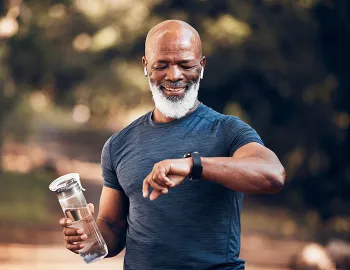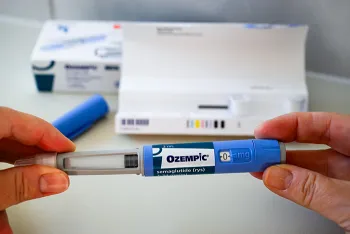A snapshot of the latest research on diet, exercise, and more

CandyRetriever - stock.adobe.com.
Here's the latest research on anxiety, pickleball injury, back pain, and more.
- Dehydration & stroke risk
- How to reduce the risk of vertebral fractures
- Pickleball & eye injuries
- Can saffron help with anxiety?
- A DASH diet for type 2 diabetes
- Could acupuncture help low back pain?
- GLP-1 drugs & cancer risk
- Can a Mediterranean diet ease psoriasis?
Dehydration & stroke risk

Does dehydration raise the risk of a stroke in older people?
Researchers examined the electronic health records (from 2018 and 2019) of 3.1 million adults aged 80 or older.
The roughly 560,000 who they identified as being dehydrated were four times more likely to have a stroke caused by a hemorrhage, two times more likely to have a stroke caused by a blocked blood vessel, and three times more likely to have a TIA (transient ischemic attack) than those who were not dehydrated.
What to do
Stay hydrated. This kind of study can’t prove that dehydration raises the risk of a stroke. Something else about the stroke patients could explain their higher risk (though the researchers did take other factors into account). But older people are more likely to become dehydrated than their younger counterparts because they may have a reduced sense of thirst, a reduced ability to concentrate urine, and reduced muscle mass (muscle holds more water than fat does). So why take a chance?
How to reduce the risk of vertebral fractures

A drug that is infused once, then again five years later, can curb vertebral fracture risk in women aged 50 to 60.
Researchers randomly assigned 1,054 women with spine or hip bone density in the normal or osteopenia (but not osteoporosis) range to get an IV infusion of zoledronate or a placebo when they entered the study, then again five years later. (Zoledronate is a bisphosphonate, like alendronate, aka Fosamax.)
In the 10 years following the first infusion, the zoledronate group had a 44 percent lower risk of having a new vertebral fracture compared to the placebo group. (A fracture occurred in 6 percent of the zoledronate takers vs. 11 percent of the placebo takers. A vertebral fracture often causes no symptoms.)
What to do
If your age and bone density match those of the women in this study, ask your doctor about zoledronate.
Pickleball & eye injuries

As pickleball climbs in popularity, so are eye injuries.
In a national database covering 2 percent of hospital emergency departments, pickleball caused 73 eye injuries between 2005 and 2024. That’s equal to 3,112 injuries nationwide, with 1,262 of them occurring in 2024 alone.
More eye injuries were caused by being hit by the ball than by a paddle or by falling. Lacerations and corneal abrasions were among the most common injuries.
What to do
Love pickleball? Maybe try some protective eyewear.
Can saffron help with anxiety?

It shows promise, says Google’s AI overview. But the evidence is shaky.
Scientists randomly assigned 51 adults with complaints of anxiety, stress, fatigue, or depressed mood to take 30 milligrams a day of saffron extract or a placebo.
After 6 weeks, the saffron takers reported no less anxiety, depression, or fatigue than the placebo takers.
What to do
Don’t depend on saffron to curb anxiety.
A DASH diet for type 2 diabetes

A DASH diet lowers blood pressure. Can it be adapted to also keep a lid on blood sugar?
Researchers randomly assigned 89 people with type 2 diabetes to a DASH diet that was tailored for diabetes (DASH4D) or a typical U.S. diet for 5 weeks each in random order.
The DASH4D diet was higher in fruits, vegetables, low-fat dairy, whole grains, beans, and nuts and lower in refined grains and sweets than the typical diet.
Average blood glucose levels were lower (by 11 milligrams per deciliter) and were “in range” (not too high or too low) for 5 percent longer on the DASH4D diet.
What to do
Try a DASH-like diet. It’s surprisingly good for (almost) whatever ails you.
Could acupuncture help low back pain?

Got chronic low back pain? Acupuncture might help.
Scientists randomly assigned 800 adults aged 65 or older who had low back pain lasting at least three months to usual medical care or to either standard acupuncture (8 to 15 treatment sessions) or enhanced acupuncture (standard plus 4 to 6 additional sessions) over 12 weeks.
After 6 months, a “clinically meaningful”—30 percent or more—improvement on a disability questionnaire was reported by 39 percent of the standard group, 44 percent of the enhanced group, and 29 percent of the usual care group.
What to do
This study isn’t a slam dunk because getting a new treatment may have biased the acupuncture group’s perception of pain. But acupuncture may help as much as typical treatments (often opioids or NSAIDs). For more, see What’s causing your back pain? Good question.
GLP-1 drugs & cancer risk

Do GLP-1 drugs like semaglutide (sold as Ozempic or Wegovy) lower—or raise—the risk of some cancers?
Scientists compared the health records from 2014 to 2024 of about 43,300 adults with obesity or overweight who were prescribed GLP-1 drugs to the records of 43,300 similar people who weren’t prescribed GLP-1 drugs.
The GLP-1 takers had a 25 percent lower risk of endometrial cancer and a 47 percent lower risk of ovarian cancer. They also had a 38 percent higher risk of kidney cancer. While the increased risk wasn’t statistically significant, it was close.
What to do
Stay tuned. It’s too early to know if GLP-1 drugs lower or raise the risk of any cancer because something else about people who take them may explain their risks. (Note: Semaglutide causes thyroid C-cell tumors in rodents, so people with a family history of certain thyroid cancers shouldn’t take it.)
Can a Mediterranean diet ease psoriasis?

Researchers randomly assigned 37 people with psoriasis to eat either a “standard low-fat diet” or a Mediterranean diet rich in extra-virgin olive oil, fruits, vegetables, beans, and whole grains, moderate in poultry, fish, and nuts, and low in dairy, red and processed meats, and sweets.
After 16 weeks, 9 of the 19 people on the Mediterranean diet—but none of the 18 on the low-fat diet—had at least a 75 percent drop in the Psoriasis Area and Severity Index.
What to do
It’s too early to know if a Mediterranean diet can curb psoriasis based on this small study. But it’s heart-healthy, so whaddya got to lose?
Support CSPI today
As a nonprofit organization that takes no donations from industry or government, CSPI relies on the support of donors to continue our work in securing a safe, nutritious, and transparent food system. Every donation—no matter how small—helps CSPI continue improving food access, removing harmful additives, strengthening food safety, conducting and reviewing research, and reforming food labeling.
Please support CSPI today, and consider contributing monthly. Thank you.

The latest
Our best (free) healthy tips
Our free Healthy Tips newsletter offers a peek at what Nutrition Action subscribers get—scrupulously researched advice about food of all kinds, staying healthy with diet and exercise, and more.

